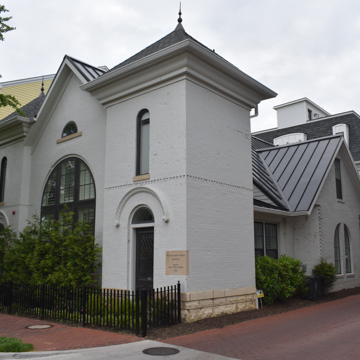Morton Street Church served as a religious and social anchor for the African American neighborhood of Columbia Heights. Among the neighborhood’s most well-known residents was Duke Ellington, who lived here in the early 1920s. Built for the Trinity African Methodist Episcopal (AME) Zion Church, the structure was William Sidney Pittman’s first commission as a professional architect and the last of his three remaining religious designs in the city. The building took up a small corner of the block and featured two bulky towers with pitched roofs; the central structure in between the towers also fashioned a sloping roof with a set of arched windows. It was built of brick with minimal decoration: windows on the first level featured decorative arches and there was a slight shift in horizontal brick laying pattern on the towers. The overall design was simple yet balanced and elegant, resembling the much more elaborate Nineteenth Street Baptist Church, completed in 1871 and demolished in 1975. It, too, exhibited a similar arrangement of towers, arched windows, and doorways.
Twentieth-century development, including the creation of Meridian Hill Park, displaced many Black residents and resulted in demolition of their houses. In recent years, the residential composition of Columbia Heights has once again transformed dramatically with white and wealthy newcomers pushing out African American residents to the outskirts of the city. The introduction of the Columbia Heights Metro station likewise expedited the shift in residential demographics, resulting in the church’s closure. In 2016 developer OPaL LLC purchased the site to create a high-end condominium community. OPaL preserved the facade of Pittman's church but cleared the rest of the block to make way for 24 two- and three-level condos in three low-rise buildings. Three two-level units are built within the historic facade. The remaining structures are meant to blend with the traditional Washington row house model. While they perhaps match some local examples of row houses, they dwarf residential dwellings across the street. This transformation of the Morton Street Church is indicative of broader gentrification practices in the city, whereby historical African American sites are altered to accommodate the preferences and needs of a white, young, and wealthy demographic.
References
Hoffer, Audrey. “A Historic DC Church Building Anchors a Cluster of Multilevel Parkview Condos.” Washington Post Blogs, June 13, 2016.
Lincoln, C. Eric, and Lawrence H. Mamiya. The Black Church in the African American Experience. Durham, NC: Duke University Press, 1990.
Pinn, Anne H., and Anthory B. Pinn. Fortress Introduction to Black Church History. Minneapolis: Fortress Press, 2001.
White, James F., and Samuel S. Hill, eds.. The New Encyclopedia of Southern Culture. Vol. 1. Chapel Hill: University of North Carolina Press, 2006.

